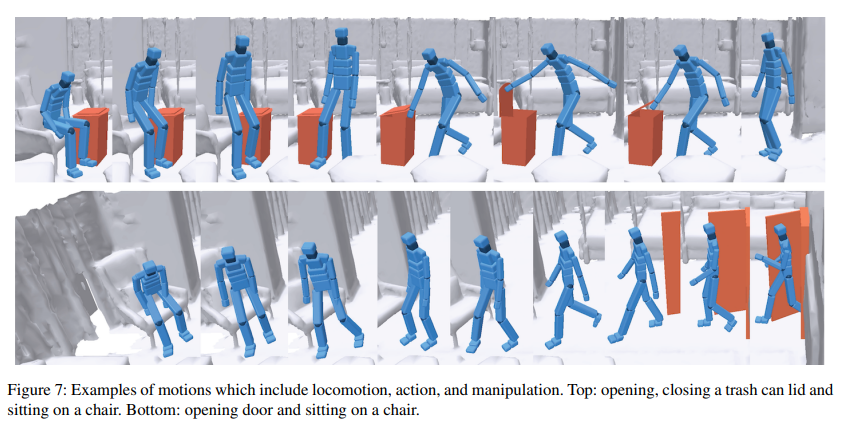Researchers from Seoul National University address a fundamental challenge in robotics – the efficient and adaptable control of robots in dynamic environments. Traditional robotics control methods often require extensive training for specific scenarios, making them computationally expensive and inflexible when faced with variations in input conditions. This problem becomes particularly significant in real-world applications where robots must interact with diverse and ever-changing environments.
To tackle this challenge, the research team has introduced a groundbreaking approach, Locomotion-Action-Manipulation: LAMA. They have developed a single policy optimized for a specific input condition, which can handle a wide range of input variations. Unlike traditional methods, this policy doesn’t require separate training for each unique scenario. Instead, it adapts and generalizes its behavior, significantly reducing computation time and making it an invaluable tool for robotic control.
The proposed method involves the training of a policy that is optimized for a specific input condition. This policy undergoes rigorous testing across input variations, including initial positions and target actions. The results of these experiments are a testament to its robustness and generalization capabilities.
In traditional robotics control, separate policies are often trained for distinct scenarios, necessitating extensive data collection and training time. This approach could be more efficient and adaptable when dealing with varying real-world conditions.
The research team’s innovative policy addresses this problem by being highly adaptable. It can handle diverse input conditions, reducing the need for extensive training for each specific scenario. This adaptability is a game-changer, as it not only simplifies the training process but also greatly enhances the efficiency of robotic controllers.
Moreover, the research team thoroughly evaluated the physical plausibility of the synthesized motions resulting from this policy. The results demonstrate that while the policy can handle input variations effectively, the quality of the synthesized motions is maintained. This ensures the robot’s movements remain realistic and physically sound across different scenarios.
One of the most notable advantages of this approach is the substantial reduction in computation time. Training separate policies for different scenarios in traditional robotics control can be time-consuming and resource-intensive. However, with the proposed policy optimized for a specific input condition, there is no need to retrain the policy from scratch for each variation. The research team conducted a comparative analysis, showing that using the pre-optimized policy for inference significantly reduces computation time, taking an average of only 0.15 seconds per input pair for motion synthesis. In contrast, training a policy from scratch for each pair takes an average of 6.32 minutes, equivalent to 379 seconds. This vast difference in computation time highlights the efficiency and time-saving potential of the proposed approach.
The implications of this innovation are significant. It means that in real-world applications where robots must adapt quickly to varying conditions, this policy can be a game-changer. It opens the door to more responsive and adaptable robotic systems, making them more practical and efficient in scenarios where time is of the essence.

In conclusion, the research presents a groundbreaking solution to a long-standing problem in robotics – the efficient and adaptable control of robots in dynamic environments. The proposed method, a single policy optimized for specific input conditions, offers a new paradigm in robotic control.
This policy’s ability to handle various input variations without extensive retraining is a significant step forward. It not only simplifies the training process but also greatly enhances computational efficiency. This efficiency is further highlighted by the dramatic reduction in computation time when using the pre-optimized policy for inference.
The evaluation of synthesized motions demonstrates that the quality of robot movements remains high across different scenarios, ensuring that they remain physically plausible and realistic.
The implications of this research are vast, with potential applications in a wide range of industries, from manufacturing to healthcare to autonomous vehicles. The ability to adapt quickly and efficiently to changing environments is a crucial feature for robots in these fields.
Overall, this research represents a significant advancement in robotics, offering a promising solution to one of its most pressing challenges. It paves the way for more adaptable, efficient, and responsive robotic systems, bringing us one step closer to a future where robots seamlessly integrate into our daily lives.
Check out the Paper and Project Page. All Credit For This Research Goes To the Researchers on This Project. Also, don’t forget to join our 30k+ ML SubReddit, 40k+ Facebook Community, Discord Channel, and Email Newsletter, where we share the latest ai research news, cool ai projects, and more.
If you like our work, you will love our newsletter..
![]()
Madhur Garg is a consulting intern at MarktechPost. He is currently pursuing his B.tech in Civil and Environmental Engineering from the Indian Institute of technology (IIT), Patna. He shares a strong passion for Machine Learning and enjoys exploring the latest advancements in technologies and their practical applications. With a keen interest in artificial intelligence and its diverse applications, Madhur is determined to contribute to the field of Data Science and leverage its potential impact in various industries.
<!– ai CONTENT END 2 –>
 NEWSLETTER
NEWSLETTER





